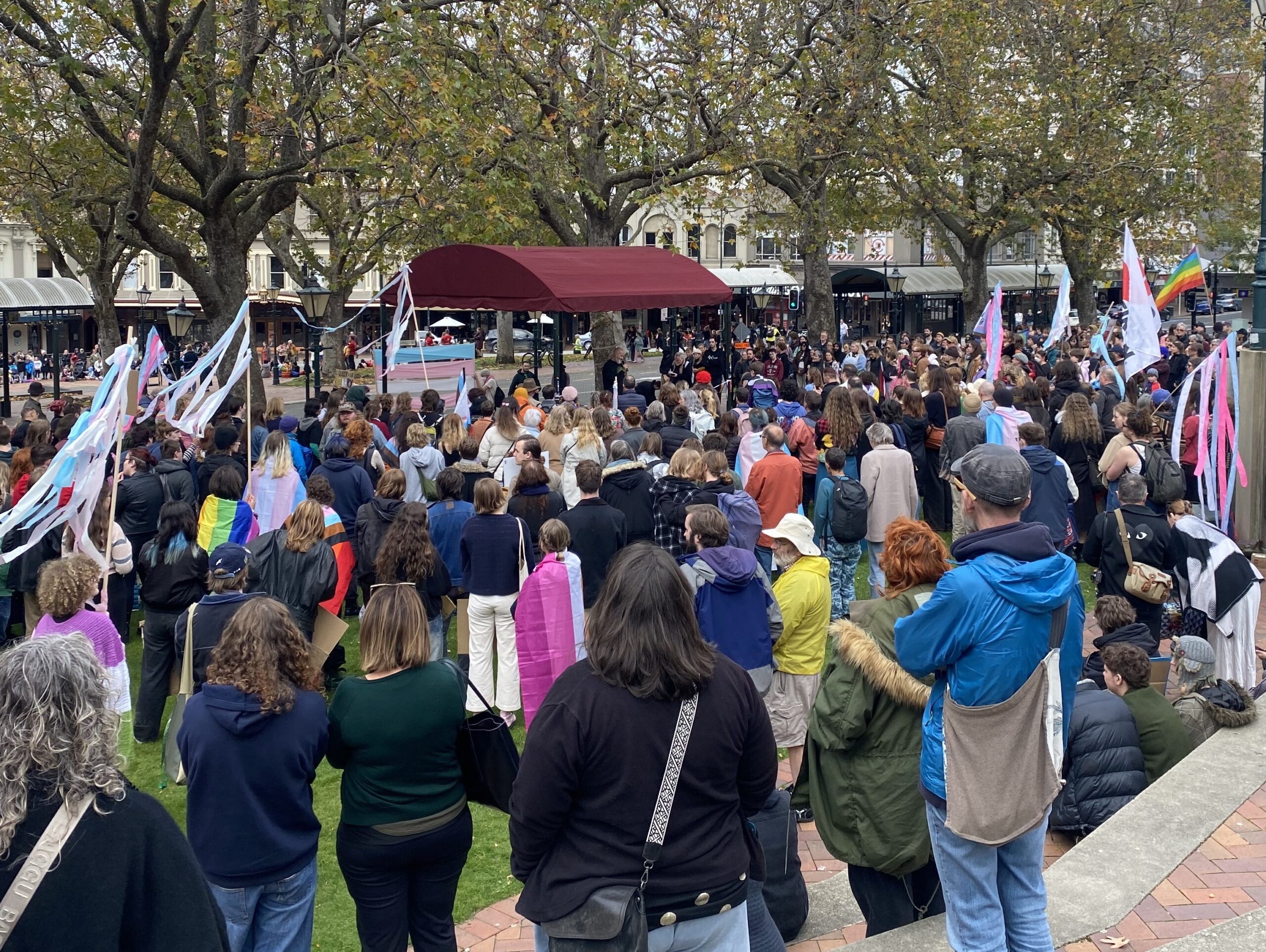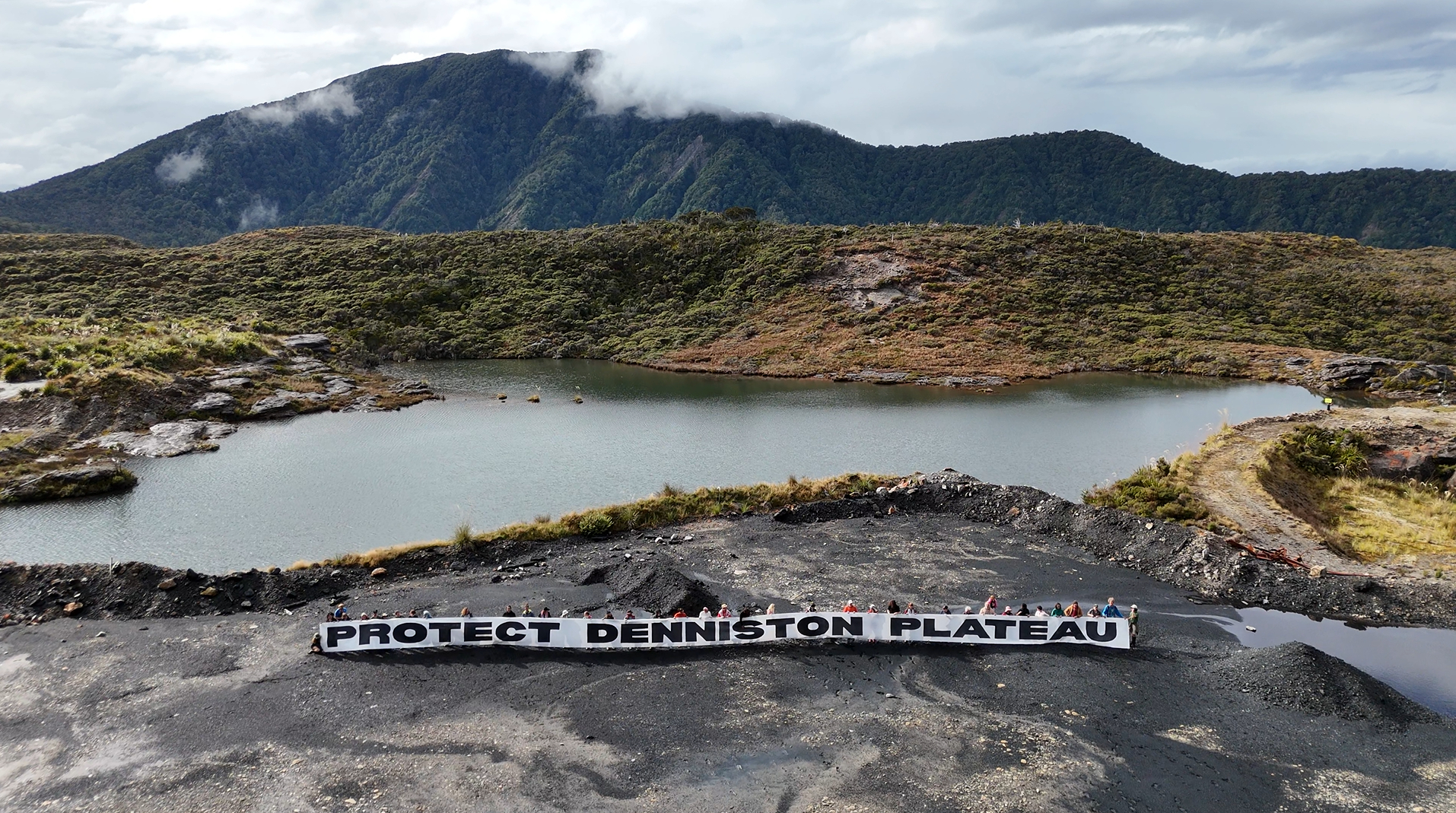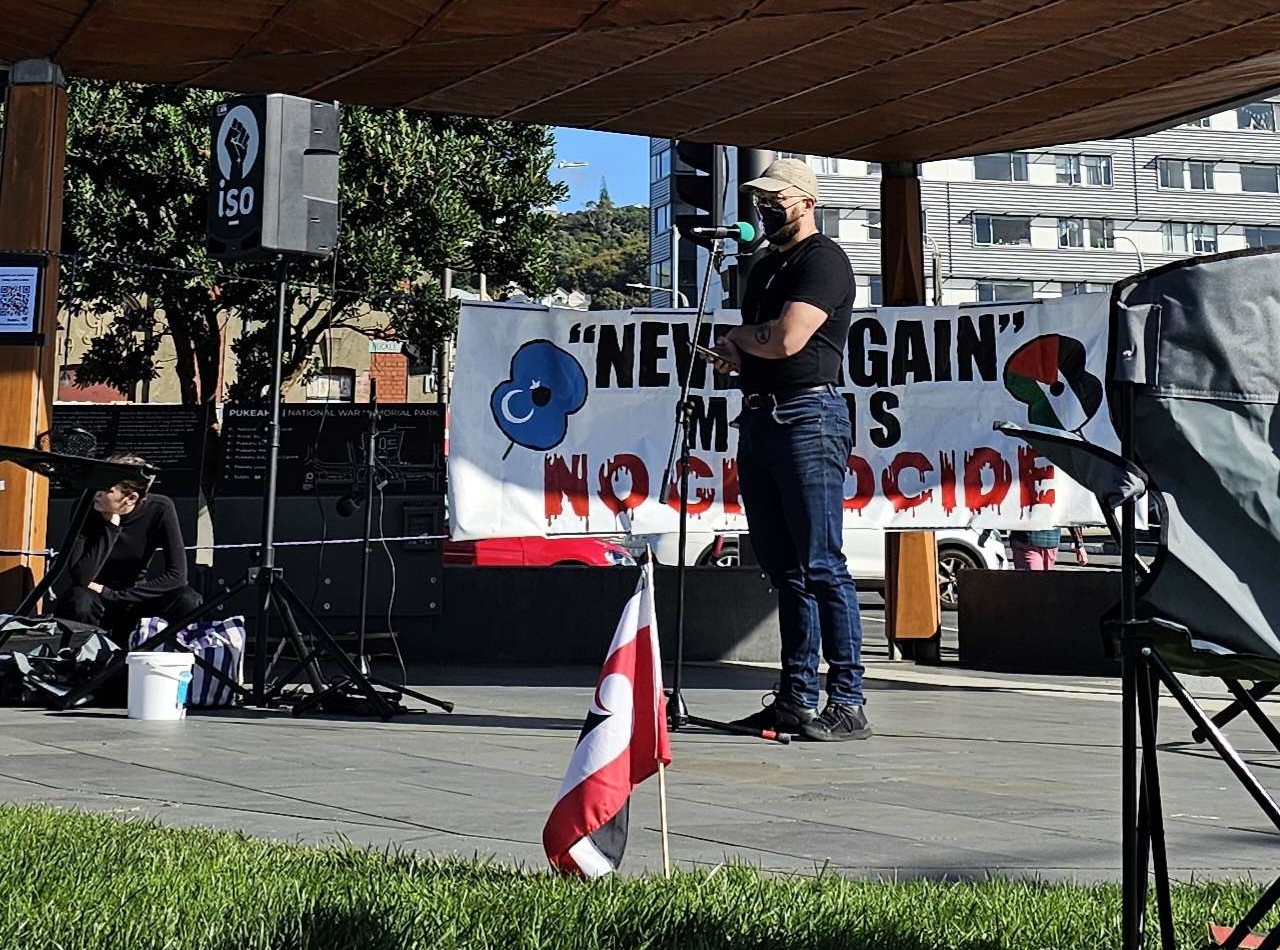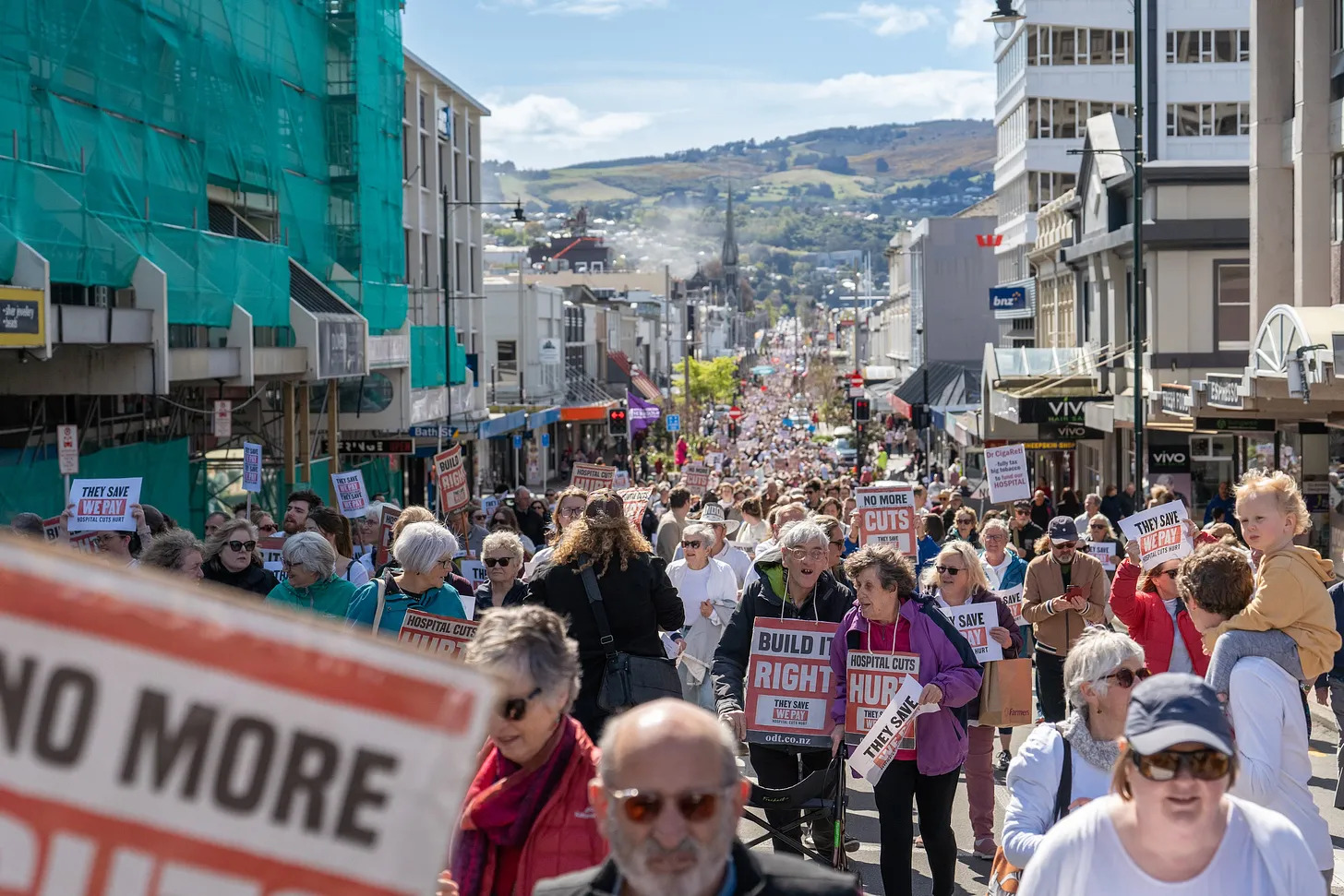July and August 2022 saw Destiny Church’s Freedom and Rights Coalition (FRC) organise several rallies around Aotearoa, most of which were counter-protested. The counter-protest in Ōtepoti was particularly successful. These FRC rallies formed a campaign culminating in a convoy from both ends of Aotearoa to converge with a march to Parliament on the 23rd August.
A united front group named Pōneke Anti-Fascist Coalition (PAFC) was formed to organise a counter-protest to the FRC. The group consisted primarily of anarchist activists from Peace Action Wellington, members of the International Socialist Organisation (ISO), and individual activists, although many other groups from the Centre and Left were invited to participate. Decision-making was achieved through online meetings and discussions, with the coalition voting on contentious issues. The Cenotaph beside parliament was selected as the location of the counter-protest. This is a reasonably large plaza area that could hold a decent-sized gathering safely without impeding street traffic. The site had been within the area claimed by the February “freedom” hooligans, and as such the location also had symbolic significance to PAFC in defiance of the threat of return of a similar damaging encampment.
Two ISO writers have recently described the Freedom and Rights Coalition in their analysis as being politically right-wing but not strictly fascist: see this article about anti-far-right organising in Ōtepoti; and this article which analyses the politics of the FRC in detail. However, the effects of the “freedom” propaganda and associated mobilisations are to increase opportunities for more clearly fascist discourse and activity. This effect applies to right-wing political parties such as the National Party and ACT, currently spotlighted far-right groups such as the FRC, or from currently peripheral but truly fascist groups such as Action Zealandia and National Front New Zealand. The anti-fascist banner of our united front was justified in that it opposed existing fascist groups and also any potential rightward drift that far-right actions might generate.
PAFC faced the challenge of encouraging a mass of people to directly confront the FRC and others from the “freedom” crowd, given wide-spread apprehension following intimidation and violence from the February occupiers. We therefore elected for the counter-protest to be non-violent. This included explicitly planning to avoid blocking the path of the FRC march so as to avoid provoking a clash. In media leading up to the event, and in written and verbal form at the start of and during the rally, PAFC emphasised the kaupapa of non-violence, and of de-escalation when face-to-face conflict did occur. During planning, it was agreed that, although ensuring the far right’s march didn’t go unopposed, at least on this occasion PAFC would be prepared to withdraw from the chosen counter-protest site if remaining there meant the community risked violence being brought upon them.
The goals of this action were identified as follows: ensuring the community voice was represented; ensuring the advocates of disinformation and of bigotry knew they were opposed; and enabling the community to celebrate our diversity through song and dance while supporting one another’s well-being.
Mana Whenua were included in preparations for the counter-protest, and the rally space was cleared with karakia before speeches and chants commenced. The non-violent kaupapa did not inhibit any messaging about the danger of disinformation. PAFC’s chants and placards were clear in their opposition to the leaders of the FRC and to any politics of bigotry. Chants included “Stand together: straight and gay. Make FRC go away!” and “Tangata Whenua, Pacifica, Muslim, Asian and White: Unite! Unite! Unite to fight the Right!”. A range of speakers and speeches from people across Aotearoa were heard. Video of many of these speeches can be found on the Pōneke Anti-Fascist Coalition Facebook page . The kaupapa was clearly summarised in rainbow-coloured lettering on a banner proudly displayed at the centre of the counter-protest: “Love community. Hate fascism”
Another right-wing group from the February “freedom” milieu is Voices For Freedom (VFF). While they continue to advocate conspiracism and disruption, VFF has more recently been advocating against their followers participating in mass convoys and marches. Instead, VFF is orienting itself towards promoting candidates for local electoral positions with the stated libertarian goal of political sabotage to make Aotearoa “ungovernable”. Meanwhile, the FRC’s other potential allies such as the Outdoors and Freedom Party are already showing signs of being poorly aligned with Brian Tamaki’s political aspirations. Perhaps the alliances shown earlier in 2022, which contributed to the parliament occupation dragging on for so long, are less likely to be repeated in near future. Meanwhile, the self-identified Nazi Counterspin Media’s Instagram account has been suspended and their leaders arrested. This will be at least temporarily decreasing the proliferation of “freedom” and other far-right organising information in Aotearoa. However, Destiny Church is well-funded and well-organised, with branches across Aotearoa. Although their leaders prey on the working class both financially and spiritually, they nonetheless currently have a not-insignificant following. The combined effect of these dynamics on the day of the FRC counter-protest was encountering the far-right actors in two distinct waves.
First, from soon after PAFC assembled on the Cenotaph, a small group of enthusiastic far-right hecklers of unidentified faction allegiance attempted disruption by calling from the edge of parliament grounds and filming. The shouts from their small gathering were ineffectual and easy to ignore, drowned out by speeches, chants, and music from the much larger PAFC gathering. Their filming, an obvious attempt to intimidate through threat of ridicule and stalking, was met with unashamed dancing, singing, music, and visual blocking by PAFC. No doubt individual far-right cretins will have felt self-satisfied with their efforts, but they completely failed to silence the assembled community or suppress the joyous celebrations.
Second, the FRC marched past the Cenotaph and into parliament. The FRC contingent was a significantly larger but more cohered group than the first. The swell in numbers emboldened a handful of the “freedom” protesters generally, who at this point threatened with fists, grabbed banners, and pushed onto the Cenotaph in ones and twos. PAFC were shortly afterwards able to non-violently expel these threats by physically blocking entry, not engaging with their talking points, and re-iterating our non-acceptance of their conspiracist talking points which they were trying to raise verbally and on placards. Sadly however, during this period of increased tension it did appear some counter-protesters left the site – likely as a response to the intimidation and threats experienced from the far-right. It’s certain the FRC and other far-right perspectives are not the majority opinion amongst the people in either Aotearoa generally or in Te Whanganui-a-Tara specifically. However, the Left certainly has significant work to do to convince a larger proportion of the working class to directly stand up to the far-right threat. Greater numbers on the PAFC side would have significantly changed the energy of the brief but intense period when the far-right and counter-protesters were face-to-face.
There is a need for socialist and labour groups to become involved in this anti-far-right and anti-fascist organising. A number of unions were contacted. A handful of union banners were present at the counter-protest, but the Tertiary Education Union Te Herenga Waka branch alone made a crystal clear public declaration of support. Labour unions need to be more cognisant of the danger posed to the working class of far-right agitation, and they should use their significant communications infrastructure to mobilise their members to important rallies such as this. Socialist groups in addition to ISO could usefully provide political insight as well as providing people to share the significant workload of organising further actions.
There are several tactical decisions relating to planning and decisions made on the day which PAFC will continue to review so we can better represent the community view on health and inclusivity, and so we can better fight the far-right threat in the future. An obvious question readers of this article from elsewhere in the world might be asking is whether we selected the correct kaupapa for this action, given the anti-fascist banner of the coalition. Historically, pacifism has always failed to successfully counter true fascism, and when fascist movements have formed they have invariably grown unless directly confronted. The capitalist state can’t be relied on to suppress fascism, since it is a useful tool of capitalism against the working class in times of crisis. Therefore the working class must themselves confront fascist threats. However, the type and degree of confrontation should be balanced in proportion to the fascistic elements in a movement. A few self-identified fascists have certainly taken the opportunity to rally with the FRC, but most of the “freedom” protesters at this time are situated in a far-right political space which is not quite so extreme as to be fascist. Although PAFC has an an overarching goal of ensuring fascism doesn’t develop, it might be more correct to identify PAFC’s recent work in softer terms: anti-individualism; and pro-community. The non-violent counter-protest approach was appropriate for the current local political situation, and for the particular work that was undertaken.
PAFC successfully demonstrated, or rather reiterated, it is possible to counter-protest the far-right in Te Whanganui-a-Tara. Since the arrival of COVID-19 in Aotearoa, the Left has engaged with collective health measures for the protection of all, including household isolation measures and limitations on gathering sizes. As a result, the August 23rd 2022 counter-protest was one of the Capital’s few mass-mobilisations of the Left and liberals in the past several years. Over that same period, the Right has been pursuing selfish concepts of individualist “freedom” (freedom from social responsibility), organising several rallies including the February convoy and occupation. For the Right, this most recent march to parliament was the culmination of previous work. For the Left, however, the PAFC counter-protest was just a first step. There is more work to do in countering far-right organising and extinguishing the possibility of the growth of fascism. But as a result of successfully protesting for collective well-being and for the rights of the poor and marginalised to be included and be safe in society, PAFC have also somewhat reclaimed some important vocabulary for our cause. We have scrubbed the word “protest” of some of the taint of the February parliament encampment; and we have appropriately brought the term “anti-fascist” once more into the political consciousness.









